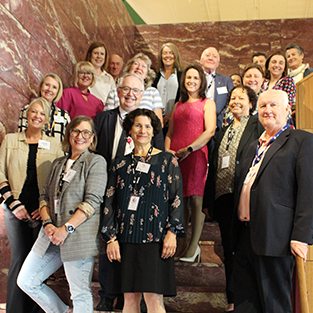Key Achievements
In 2022-23:
- The CEC established the nation's first near real-time maternity intelligence system. Weekly updated data from all public birthing facilities are aggregated and available through the QIDS MatIQ platform to provide insights into the safety and quality of maternity care.
- The CEC facilitated two state-wide Maternity Leaders Forums and four NSW Paediatric Leaders Safety and Quality Forums, collectively engaging more than 160 senior medical, midwifery and nursing clinicians to foster stronger safety systems and leadership within each maternity service and paediatric unit.
- The CEC continued to lead and enhance the state-wide Respiratory Protection Program with participation from more than 100,000 health workers.
- The CEC redesigned the infection prevention and control response and escalation framework for managing infections across healthcare facilities. This responded to the changing landscape, outlining new alert levels to determine measures for preventing and managing acute respiratory infections.
- For its Safety Culture Framework, the CEC led a Symposium on Restorative Just Learning Culture and workshops on Introductory Restorative Skills with 130 participants from 15 LHD/SHNs. The CEC published a Guide to Co-developing Restorative Just Learning Culture.
- The CEC risk-assessed 828 issues notified by Therapeutic Goods Administration (778) and other agencies, including medical devices (627), medicines (123) and biological agents (78), with an increase in Class I notifications (17 system-wide critical responses, 47 safety alert broadcasts).
- The CEC established the Medical Device Governance Program to the coordinate the implementation of the Therapeutic Goods Administration (TGA) Medical Device Reforms with other NSW Health agencies and identified stakeholders to improve patient safety for medical devices.
- The CEC developed comprehensive training and eLearning modules for staff involved in Serious Adverse Event Reviews to support new NSW Health investigating and reporting requirements. Nearly 500 staff engaged in SAER fundamentals, methodologies, and team leader workshops.
- The CEC supported LHDs/SHNs with transitioning to the new NSW Medicines Formulary for medicines initiated in hospitals. The formulary governs the procurement and use of pharmaceuticals to support optimum clinical governance, better value health care and improved patient outcomes.
- The CEC created and implemented a suite of resources to support reflective practice and staff wellbeing. Reflecting on one's work is integral to the safety and quality of healthcare. Reflective practice transforms the human experience of caring.
- The CEC developed the Safety and Quality Essentials Pathway evaluation plan and conducted the first Partnership Survey with 19 NSW Health entities. The plan guides measurement of the impact and value of the pathway in strengthening safety system capability.
Safety culture and restorative just learning culture

Healthcare Safety Culture Framework
The CEC has developed a safety culture framework that includes the five elements of James Reason's (1998) safety culture with the addition of Sydney Dekker's restorative culture (2016) and high trust. In a restorative culture, organisations and employees aim to repair trust and relationships damaged after a serious healthcare harm, collaboratively decide what should be done to restore wellbeing and trust and to prevent further harm. A Restorative Just and Learning Culture (RJLC) is supported by systems thinking, commitment to system improvement, collective, shared leadership and co-development. The element of high trust is included as the need for trust in a safety culture is the foundation from which openness, learning and reporting can occur. The framework is underpinned by compassionate leadership.
In 2023 the CEC worked to raise awareness and engagement with RJLC across NSW Health. In May 2023 a CEC-held symposium on RJLC was well attended by staff from 15 LHD/SHNs. The symposium showcased work already occurring in some LHDs and ensured a baseline awareness across NSW Health.
The CEC has worked to upskill key staff to support and drive a RJLC locally. This included sponsoring workshops in introductory restorative skills and training an initial cohort in Systems Engineering Initiative in Patient Safety (SEIPS). The SEIPS framework is used in the NHS and New Zealand to assist understanding of the systems and human factors influencing the delivery of safe and reliable care.
In June 2023, the CEC published the Guide to Co-developing a Restorative Just and Learning Culture to support LHD/SHN implementation.
A new framework for Infection Prevention and Control

NSW IPAC Framework for Respiratory and COVID-Safe Healthcare
Responding to COVID-19 continued to be a major focus of the HAI team over the past 12-months as healthcare services balanced COVID-19 responses with returning to normal services. Mask mandates remained for health services which created a challenge given the change in community mask mandates. The CEC's guidance required ongoing consultation and discussion to ensure we had the most effective approach to keep patients, staff and visitors safe.
In 2023, the CEC reviewed and improved the risk levels and matrix that guided the NSW COVID-19 response, broadening the scope to include COVID-19 under the category of "acute respiratory infections" or ARIs. There was considerable work done to fine-tune the existing guidance into one foundation for current and future infectious threats.
With the need to ensure COVID and other acute respiratory infections have the correct management embedded into our systems, the NSW IPAC Framework for Respiratory and COVID-Safe Healthcare was developed. The framework incorporates a foundational level that underpins all the alert levels used during the pandemic. Foundational level is the core elements of infection prevention and control required to continue to protect patients, staff and visitors.
The framework allows NSW Health facilities to be prepared and responsive to changes in the threat of airborne pathogens. To support the NSW Health system during the transition to incorporate COVID within well-established IPAC systems, the CEC has continued to revise resources including Keeping our Staff Safe fact sheets and the risk matrix for staff, patients and visitors.
The IPA/HAI program also showcased evidence generation, publishing 9 articles about governance structures and governance for IPAC, respiratory protection program and IPAC leadership.
Our thanks
We thank the management and clinical staff who contributed to the preparation of this document.



